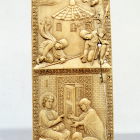Marys at the Sepulchre, ivory, 5th Century AD (inv. avori 9)
Location: Rocchetta, 2nd floor, Room XXXII
The bas-relief tablet is among the finest examples of late Roman ivories. It is a justly famous piece because it is one of the first ivory diptychs with religious content and one of the earliest known representations of the Holy Sepulchre, which appears below the images of two Evangelists: Luke, symbolised by a bull, and Mathew, by an angel. In the scene below, the women, united in mourning for the dead Saviour, encounter a character, who represents an angel or the risen Christ. The presence of only two evangelists suggests the existence of a second piece, now lost.
The doors of the building behind the women are decorated with three scenes from the Gospels, the Resurrection of Lazarus, Zacchaeus climbing the tree to see Jesus and Christ teaching the crowd. The attribution of such an early date, the 5th century AD, stems from stylistic considerations. The refined workmanship, the late Roman culture of the sculptor, and the extraordinary softness of carving, places the origin of the piece in one of the capitals of the Western Empire, probably Rome.
Once belonging to the Trivulzio Collection, the piece was purchased in 1935 by the City of Milan.








